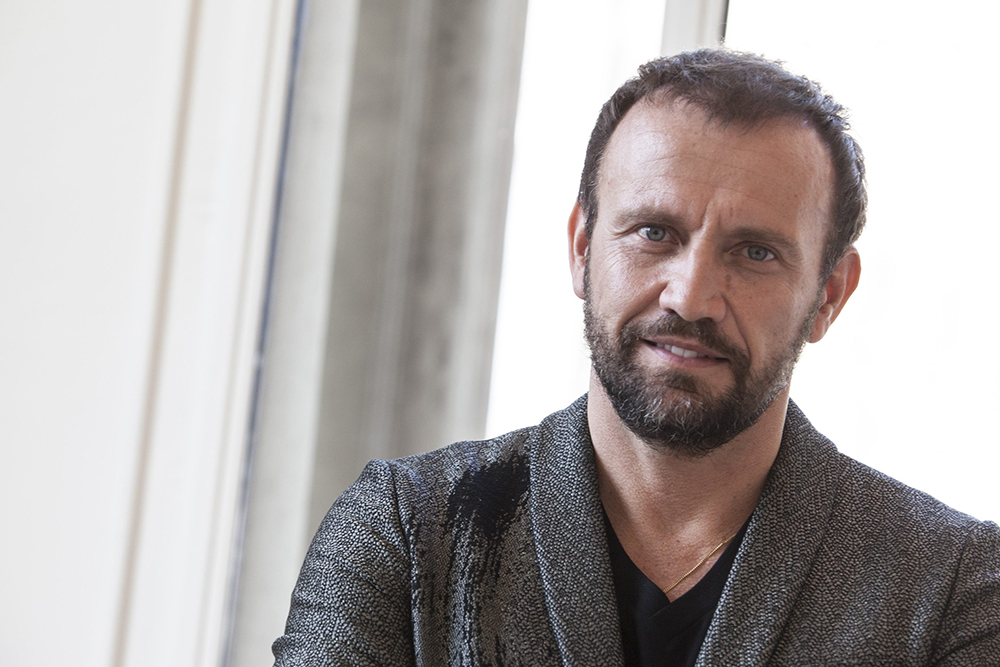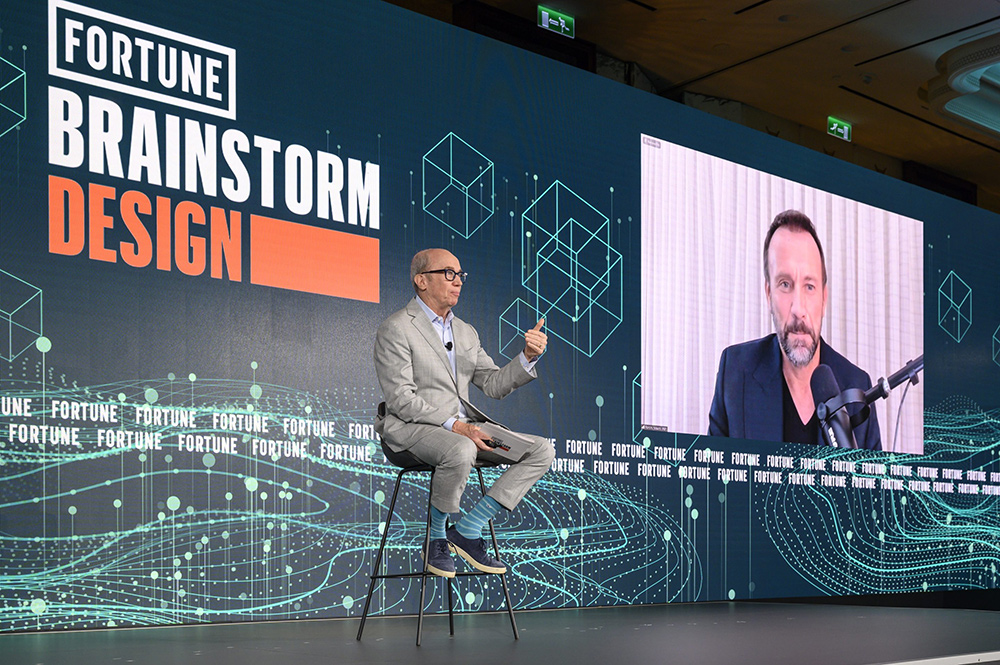百事可乐新logo设计师:设计是一种竞争优势

当马若·波西尼(Mauro Porcini )最初知道他有机会从 3M 跳槽,成为百事公司(PepsiCo)历史上第一位首席设计官时,他拒绝了这个邀请。然而当他与百事公司当时的首席执行官英德拉·努伊在法国城市格勒诺布尔(Grenoble)会面后,他重新考虑了这个决定。
“她试图重塑整个行业,完全重塑人们与食品饮料世界互动的方式,” 波西尼本周三在中国澳门举行的《财富》头脑风暴设计大会的视频对话中这样说。
波西尼说,他加入百事公司后,马上就面临了一场“火的洗礼"——公司试图应对可口可乐当时新推出的自动汽水机。2009年,百事的老对手可口可乐推出了名为“自由式”(Freestyle)的饮料机,用户可以从100 多种不同的饮料里作出自己的选择。根据顾客的选择,这项被称为 “微剂量”(microdosing)的新技术能从预装盒里喷出精确数量的浓缩香精。
波西尼说,百事想要参与竞争,“试图在这个赛场上击败(可口可乐)”。在“没有官方预算”的情况下,他开始与客户交谈,却发现花哨的新技术并不是用户想要的。
“首先,客户对价格非常敏感。他们不想花那么多钱买这种机器,”他说。另外,这些机器很大,很多客户“没有足够空间摆放它”。
他说:“我们意识到可以尝试一些不同的技术......并[利用]节省下来的部分成本,添加客户真正需要的新功能。”

百事公司于 2014 年推出了名为“螺旋塔”(Spire)触摸屏汽水机。与可口可乐的“自由式”不同,“螺旋塔”使用传统的箱体内嵌袋系统来分配汽水,价格则低于可口可乐的预装盒。“螺旋塔”体积更小,成功地为百事公司赢得了新客户。
他说,他把同样的方法带到了百事可乐的logo设计中。
在他加入时,百事可乐刚刚推出了一个新的(有争议的)logo,许多装瓶商拒绝了这个新设计。“他们认为这个设计不好,缺乏活力,”波西尼说。
但设计师知道他不能从头再来。“新logo刚刚推出,”他回忆道,“我不能马上改变它!”他对字体和颜色进行了小幅调整,终于让调整后的logo在 2013 年得到了所有装瓶商的认可。
时隔多年后,波西尼再次为百事公司设计出一个新logo,它更具复古风格,在今年早些时候首次对外亮相。
设计的竞争优势
波西尼本周三还表示,一个好的设计能为企业带来竞争优势。
这位设计师认为,企业领导者在过去可以用“其他办法来保护设计师提供的平庸产品”,使企业并不会受到平庸设计的影响。
但在一个更加全球化和数字化的世界里,这种做法行不通了。他说:“传统的商业壁垒[正在]崩溃。要么你为人们创造出非凡的东西,要么别人会取代你把它做出来。”
他最后强调:“你的最佳竞争优势就是以人为本,为人们创造价值。这是设计工作的核心。”(财富中文网)
译者:珠珠
当马若·波西尼(Mauro Porcini )最初知道他有机会从 3M 跳槽,成为百事公司(PepsiCo)历史上第一位首席设计官时,他拒绝了这个邀请。然而当他与百事公司当时的首席执行官英德拉·努伊在法国城市格勒诺布尔(Grenoble)会面后,他重新考虑了这个决定。
“她试图重塑整个行业,完全重塑人们与食品饮料世界互动的方式,” 波西尼本周三在中国澳门举行的《财富》头脑风暴设计大会的视频对话中这样说。
波西尼说,他加入百事公司后,马上就面临了一场“火的洗礼"——公司试图应对可口可乐当时新推出的自动汽水机。2009年,百事的老对手可口可乐推出了名为“自由式”(Freestyle)的饮料机,用户可以从100 多种不同的饮料里作出自己的选择。根据顾客的选择,这项被称为 “微剂量”(microdosing)的新技术能从预装盒里喷出精确数量的浓缩香精。
波西尼说,百事想要参与竞争,“试图在这个赛场上击败(可口可乐)”。在“没有官方预算”的情况下,他开始与客户交谈,却发现花哨的新技术并不是用户想要的。
“首先,客户对价格非常敏感。他们不想花那么多钱买这种机器,”他说。另外,这些机器很大,很多客户“没有足够空间摆放它”。
他说:“我们意识到可以尝试一些不同的技术......并[利用]节省下来的部分成本,添加客户真正需要的新功能。”
百事公司于 2014 年推出了名为“螺旋塔”(Spire)触摸屏汽水机。与可口可乐的“自由式”不同,“螺旋塔”使用传统的箱体内嵌袋系统来分配汽水,价格则低于可口可乐的预装盒。“螺旋塔”体积更小,成功地为百事公司赢得了新客户。
他说,他把同样的方法带到了百事可乐的logo设计中。
在他加入时,百事可乐刚刚推出了一个新的(有争议的)logo,许多装瓶商拒绝了这个新设计。“他们认为这个设计不好,缺乏活力,”波西尼说。
但设计师知道他不能从头再来。“新logo刚刚推出,”他回忆道,“我不能马上改变它!”他对字体和颜色进行了小幅调整,终于让调整后的logo在 2013 年得到了所有装瓶商的认可。
时隔多年后,波西尼再次为百事公司设计出一个新logo,它更具复古风格,在今年早些时候首次对外亮相。
设计的竞争优势
波西尼本周三还表示,一个好的设计能为企业带来竞争优势。
这位设计师认为,企业领导者在过去可以用“其他办法来保护设计师提供的平庸产品”,使企业并不会受到平庸设计的影响。
但在一个更加全球化和数字化的世界里,这种做法行不通了。他说:“传统的商业壁垒[正在]崩溃。要么你为人们创造出非凡的东西,要么别人会取代你把它做出来。”
他最后强调:“你的最佳竞争优势就是以人为本,为人们创造价值。这是设计工作的核心。”(财富中文网)
译者:珠珠
When Mauro Porcini was offered the chance to jump ship from 3M and become PepsiCo’s first-ever chief design officer, he initially turned it down. It took a meeting with then-CEO Indra Nooyi in the French city of Grenoble to get him to reconsider.
“She was trying to reshape an entire industry, an entire way of interacting with the world of food and beverage,” Porcini said Wednesday in a video conversation at Fortune‘s Brainstorm Design conference in Macau, China.
Immediately after joining PepsiCo, Porcini said he faced a “baptism of fire” in the company’s attempt to respond to Coca-Cola’s then-novel soda dispensing machine. PepsiCo’s archrival launched its Freestyle dispenser in 2009, which allowed users to choose from over 100 different drinks on demand. The technology, called microdosing, used cartridges to spurt out a precise amount of flavored concentrate to match to a customer’s choice.
Porcini said he felt Pepsi wanted to compete and “try to beat [Coca-Cola] at the same game.” Instead, with “no official budget,” he started talking to customers and found that the fancy new technology didn’t meet what users wanted.
“Customers, first of all, were very price-sensitive. They didn’t want to spend so much money for those kinds of machines,” he said. Plus, the machines were big, so many customers didn’t “have the space.”
“We realized that eventually there was an opportunity to use a different technology…and [use] some of the cost savings in adding additional features that were really relevant to the customer,” he said.
PepsiCo launched its touchscreen dispenser Spire in 2014. Unlike Coca-Cola’s Freestyle, the Spire used the traditional bag-in-box system to dispense soda, which was cheaper than the cartridges in Coca-Cola’s technology. The Spire’s smaller footprint succeeded in winning new customers for PepsiCo.
On Wednesday, Porcini said he brought that same approach to Pepsi’s logo. The company, at the time, had just debuted a new (and controversial) logo, but many bottlers rejected the new design. “They didn’t think it was the right one, didn’t have the right energy,” Porcini said.
But the designer knew he couldn’t just start again from scratch. “We just launched the new logo,” he remembered. “I couldn’t change it right away!” Instead, he resorted to small tweaks to the font and the color, and got all bottlers on board by 2013. Porcini was eventually able to design a new, more retro-style logo for Pepsi, which the company debuted earlier this year.
Design’s competitive advantage
On Wednesday, Porcini argued that design now offers companies a competitive advantage.
Companies could get away with a shoddy product in the past, the designer argued, as business leaders could use “other levers to protect…the mediocrity of your offering.”
But that doesn’t fly in a more globalized and digital world. “The traditional barriers to entry of business… [are] crumbling down,” he said. “Either you create something extraordinary for people, or somebody else will do it on your behalf,” he said.
“Your best competitive advantage is human-centricity, creating value for people. And design is all about this,” he concluded.













